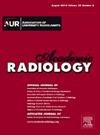全氟丁烷对比增强超声波造影诊断胸膜下肺部病变的准确性
IF 3.8
2区 医学
Q1 RADIOLOGY, NUCLEAR MEDICINE & MEDICAL IMAGING
引用次数: 0
摘要
理论依据和目的研究全氟丁烷增强超声(US)检查在区分胸膜下肺部良性和恶性病变方面的诊断价值:这项单中心回顾性研究招募了2022年1月至2023年3月期间连续出现胸膜下肺部病变的患者。肺部病变的原因通过活检和随访检查得到确认。使用全氟丁烷增强 US 对病变进行 0-180 秒的连续评估,并在 3、5 和 10 分钟后观察洗脱(WT)情况。通过单变量和多变量分析确定了重要的 US 特征,并对其诊断性能进行了评估。此外,还通过多变量逻辑回归分析评估了结合多个特征预测肺部恶性病变的诊断性能:共纳入 70 个病例(17 个良性病灶[13 男,4 女;平均年龄:57.5 ± 12.2 岁]和 53 个恶性病灶[41 男,12 女;平均年龄:63.3 ± 11.6 岁])。恶性和良性病变的峰值强度(PI)、到达时间(AT)和 10 分钟后的 WT 均有显著差异。10 分钟 WT 的灵敏度和准确度明显高于 AT(均为 p 结论:PI 和 AT 的灵敏度和准确度均高于 WT:全氟丁烷增强 US 能区分肺部良性和恶性病变,结合 AT、PI 和 10 分钟 WT 进行诊断的效果优于单一特征。本文章由计算机程序翻译,如有差异,请以英文原文为准。
Accuracy of Contrast-enhanced Ultrasonography with Perfluorobutane for Diagnosing Subpleural Lung Lesions
Rationale and Objectives
To investigate the diagnostic value of perfluorobutane-enhanced ultrasound (US) examinations for differentiating benign from malignant subpleural lung lesions.
Methods
This single-center, retrospective study enrolled consecutive patients with subpleural lung lesions between January 2022 and March 2023. The cause of the lung lesions was confirmed by biopsy and follow-up examinations. The lesions were continuously evaluated using perfluorobutane-enhanced US for 0–180 s, and washout (WT) was observed after 3, 5, and 10 min. Univariate and multivariate analyses were used to identify significant US features, which were evaluated for their diagnostic performance. The diagnostic performance of combining several features for predicting malignant lung lesions was also assessed by multivariate logistic regression analysis.
Results
Seventy cases were included (17 benign lesions [13 men, 4 women; mean age: 57.5 ± 12.2 years] and 53 malignant lesions [41 men, 12 women; mean age: 63.3 ± 11.6 years]). Peak intensity (PI), arrival time (AT), and WT after 10 min significantly differed between malignant and benign lesions. The sensitivity and accuracy were significantly higher for 10-minute WT than for AT (both p < 0.05). The area under the curve of the combined diagnostic evaluation with AT, PI, and 10-minute WT was 0.897 (95% [CI]: 0.806–0.988), which was significantly higher than that of AT or PI alone.
Conclusion
Perfluorobutane-enhanced US can differentiate benign from malignant lung lesions, and combining AT, PI, and 10-minute WT for diagnostic purposes performed better than a single feature.
求助全文
通过发布文献求助,成功后即可免费获取论文全文。
去求助
来源期刊

Academic Radiology
医学-核医学
CiteScore
7.60
自引率
10.40%
发文量
432
审稿时长
18 days
期刊介绍:
Academic Radiology publishes original reports of clinical and laboratory investigations in diagnostic imaging, the diagnostic use of radioactive isotopes, computed tomography, positron emission tomography, magnetic resonance imaging, ultrasound, digital subtraction angiography, image-guided interventions and related techniques. It also includes brief technical reports describing original observations, techniques, and instrumental developments; state-of-the-art reports on clinical issues, new technology and other topics of current medical importance; meta-analyses; scientific studies and opinions on radiologic education; and letters to the Editor.
 求助内容:
求助内容: 应助结果提醒方式:
应助结果提醒方式:


